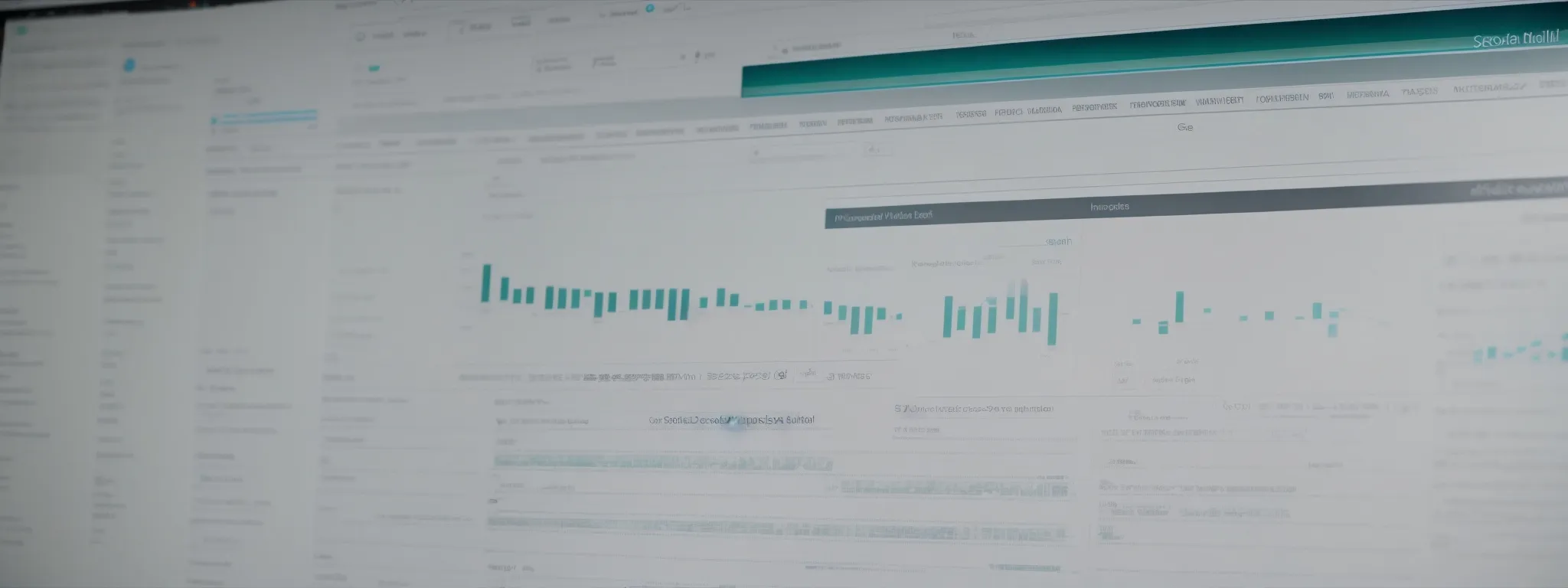Fixing Errors: Ecommerce SEO Websites
Troubleshooting Common SEO Problems on Ecommerce Websites Navigating the world of ecommerce can be a treacherous journey, especially when technical SEO issues threaten to derail a site’s […]
Troubleshooting Common SEO Problems on Ecommerce Websites
Navigating the world of ecommerce can be a treacherous journey, especially when technical SEO issues threaten to derail a site’s visibility and sales.
From the vexing presence of duplicate content to the nuances of mobile-first rendering, there is a plethora of common troubles that test even the most seasoned webmasters and developers.
LinkGraph’s adept SEO services hone in on these challenges, applying a tailor-made amalgam of expertise and innovative tools like SearchAtlas SEO software to optimize digital storefronts.
With a strategic approach, this professional guidance transforms ecommerce platforms into search engine favorites, inviting more consumers to explore and purchase products.
Keep reading to uncover the resolution to these prevalent SEO conundrums, ensuring your ecommerce site reaches its full potential in search rankings.
Key Takeaways
- Ecommerce Sites Must Prioritize Unique Content and Address Duplicate Content Issues to Maintain Search Engine Rankings
- Optimizing for Mobile Usability and Speed Is Essential in a Mobile-First Indexing Landscape for SEO Performance
- Strategic Use of 301 Redirects and Canonical Tags Is Crucial for Maintaining Link Equity and Avoiding SEO Penalties
- Regular Monitoring and Updating of Product Pages for Current Stock Status Is Important for User Experience and SEO Health
- Implementing a Robust SEO Strategy Including Page Speed Optimization and Error Resolution Ensures Strong Online Presence Post-Site Migration
Identifying Duplicate Content Issues on Your Site

In the competitive expanse of ecommerce, search engine visibility stands as the linchpin of business success, where unique content serves as a fundamental criterion for differentiation.
Ecommerce websites frequently grapple with the issue of duplicate content, which can dilute their search engine ranking and divert traffic to less authoritative pages—detrimental outcomes for any company’s bottom line.
Addressing these concerns requires methodical steps to identify and resolve redundancies.
Identifying duplicate content involves the incorporation of advanced identifying tools, configuring the preferred domain, streamlining site architecture through redirects, and articulating clear directives to search engines via canonical tags.
Below, each step is elucidated, paving the way to bolster an ecommerce site’s standing in the search engine battleground.
Step 1: Use a Duplicate Content Checker Tool
The journey to a pristine ecommerce platform begins with a surgical examination of its content, starting with Step 1: Utilize a Duplicate Content Checker Tool. LinkGraph’s comprehensive SEO services offer vital tools like SearchAtlas SEO software, which includes a sophisticated feature for free backlink analysis as well as a duplicate content checker to isolate and scrutinize instances of content repetition.
Effectiveness in resolving SEO issues hinges on precision and depth; hence, this initial step is not about merely identifying duplicate text, but also about analyzing the nuances of meta tags, product descriptions, and even similar page titles that could confuse search engine bots. By harnessing the capabilities of SearchAtlas, developers can gain a clear overview of duplicate content issues and begin devising strategies to enhance their web page’s uniqueness and search engine appeal.
Step 2: Set Preferred Domain in Google Search Console
LinkGraph’s SEO experts recognize the significance of a clearly defined preferred domain in the eyes of search engines. To this end, configuring the preferred domain setting in Google Search Console enables ecommerce sites to signal their chosen URL structure, whether it be with or without the ‘www’ prefix. This step is crucial in preventing search engines from viewing the site’s various versions as separate entities, thereby reducing the risk of content duplication penalties.
Clarity in communication with search engine bots is foundational for an effective SEO strategy, and setting the preferred domain forms part of this dialogue. This decisive action ensures consumer searches direct to the intended version of the website, thus consolidating domain authority and reinforcing the site’s search engine ranking—a testament to the efficacy of LinkGraph’s on-page SEO services.
Step 3: Implement 301 Redirects for Duplicate Pages
In the realm of ecommerce SEO, eradication of duplicate content extends to the judicious use of 301 redirects. These permanent redirects deftly guide users and search engine bots from redundant URLs to the authoritative page, ensuring that link equity is consolidated and not fragmented across multiple duplicate pages.
LinkGraph’s professional team advocates for the strategic deployment of 301 redirects as a critical component of technical SEO. By streamlining the site’s architecture in this manner, ecommerce businesses safeguard their search rankings while enhancing the user experience, paving the way for improved conversions and customer satisfaction.
Step 4: Add Canonical Tags to Specify Preferred URLs
In step four, the implementation of canonical tags becomes a key strategy for informing search engines of a user’s preferred URL for content that appears in multiple locations. This element, a cornerstone of on-page SEO services, essentially guides search engine bots to treat a chosen URL as the ‘master’ page, thereby mitigating issues of content redundancy and potential dilution of page authority.
LinkGraph’s SEO experts adeptly integrate canonical tags as part of a comprehensive SEO content strategy, ensuring their clients’ ecommerce platforms direct search engine bots to the most relevant product page. Effectively employed, these tags consolidate SEO efforts, fortifying the prominence and credibility of the main product page in the search engine results page (SERP).
Resolving Poorly Executed Site Migrations

Facilitating a migration of an ecommerce website stands as a testament to a company’s pursuit of growth and betterment.
Yet, amid the complexity of such transitions, SEO problems can arise—commonplace issues often stemming from an inadequately strategized site move.
These SEO challenges, if not swiftly and effectively addressed, could potentially cripple a website’s visibility and undermine its established digital presence.
To ensure a seamless transition, the troubleshooting of post-migration SEO issues necessitates a structured approach, beginning with a comprehensive audit of the previous site’s structure, followed by establishing accurate redirects for updated URLs, and culminating in the diligent update of all internal links.
Subsequent to these changes, a vigilant monitoring of site traffic and indexation is imperative to conclude a successful site migration.
Each of these pivotal steps forms the backbone of LinkGraph’s robust SEO services, designed to mitigate transitional disruptions and maximize an ecommerce website’s performance in the digital landscape.
Step 1: Audit Your Old Site Structure
An exhaustive audit of the previous site’s architecture marks the inaugural step towards rectifying the pitfalls of a site migration. LinkGraph’s adept SEO team employs their skills and tools, including the comprehensive SearchAtlas SEO software, to dissect and analyze the site’s URL structure, sitemap, and internal linkages to create a blueprint for seamless transition.
This analytic process is tailored to uncover any SEO errors or oversights that could compromise a website’s integrity following migration. It involves a critical review of the existing on-page elements and a free SEO audit to ensure that SEO metrics retain their robust standing amidst the website’s evolution.
Step 2: Map Out Redirects for Changed URLs
After the initial pinpointing of inconsistencies during the audit phase, the subsequent prerogative involves the meticulous planning of redirects for any and all changed URLs: a pivotal step in preserving search rankings. LinkGraph’s SEO expertise is manifest in their capacity to diligently map every altered URL, ensuring that 301 redirects are properly established from the old web page to the new, relevant destination, thus maintaining link equity and continuity for both users and search engines.
| Old URL | New URL | Redirect Type |
|---|---|---|
| /category/product-A-old | /category/product-A-new | 301 Permanent Redirect |
| /subcategory/item-B-old | /subcategory/item-B-new | 301 Permanent Redirect |
Executing a flawless strategy through the skillful creation of redirects, LinkGraph engenders trust in their ecommerce SEO services and supports the seamless navigation for users and search engine bots alike. Each redirect serves as a beacon, guiding traffic without interruption to the most relevant, updated content, and in doing so, fortifies the ecommerce site’s user experience and search engine standing.
Step 3: Update Internal Links to Reflect New Structure
The systematic refinement of a website’s internal linking architecture is the next crucial phase in overcoming migration barriers for ecommerce entities. LinkGraph’s astute attention to detail ensures that all internal links on the site reflect the new URL structure, which stabilizes navigation flow and bolsters the strength of the newly established site hierarchy.
As a central element of this intricate process, LinkGraph’s SEO specialists meticulously update links within product descriptions, category pages, and informational content to align with the redesigned site patterns. This cardinal step not only supports the crawler’s understanding of site context but also serves to sustain the user’s journey across the ecommerce platform, thereby reinforcing the relative standing of each web page in terms of SEO impact.
Step 4: Monitor Traffic and Indexation Post-Migration
Upon successful completion of a site migration, the scrutiny of traffic patterns and indexation status becomes the focal point for LinkGraph’s SEO team. It is essential to continually monitor these facets as they serve as indicators of the new site’s health and can provide insights on whether search engines are correctly mapping and ranking the updated ecommerce website.
LinkGraph’s SEO services extend to tracking shifts in search rankings and user engagement, which might illuminate areas for further optimization or signal the need to address technical hitches that may impede the newly structured site’s performance. This vigilant assessment forms the bedrock of sustaining a robust online presence in the aftermath of pivotal structural changes.
Correcting Broken Links and Lost Backlinks

With the digital marketplace becoming increasingly crowded, ecommerce websites must maintain an impeccable online infrastructure to ensure high visibility and user engagement.
Broken links, both external and internal, can derail a meticulously crafted SEO strategy, leading to a poor user experience and damaging the site’s rapport with search engines.
Furthermore, lost backlinks can weaken a site’s authoritative stature, an essential component to earning top SERP positions.
By adopting a proactive stance, ecommerce businesses can address these disruptions, starting with identifying problematic links, seamlessly repairing or redirecting them, communicating with webmasters to restore lost connections, and employing robust link building techniques to acquire new, valuable backlinks.
This systematic restoration and enhancement of a website’s link profile is crucial for maintaining and improving search engine rankings, ultimately capturing the attention of consumers and driving profitable traffic to the ecommerce platform.
Step 1: Identify Broken External and Internal Links
Initiating the remedy for broken links begins with their detection. LinkGraph’s SearchAtlas SEO software surpasses expectations with its ability to unearth both external and internal link issues rapidly. The tool’s precision facilitates swift identification, ensuring that no defective link evades the Meticulous Scrutiny required to maintain an ecommerce site’s health and search engine viability.
Once identified, LinkGraph’s SEO services take the helm in addressing the interruptions to a smooth user journey caused by broken links. The team’s combined experience, rooted in the vitality of the digital marketplace, equips them to tackle these disruptions with a keen eye, reinstating the strength of the link structure to bolster the user experience and maintain the site’s indispensable rapport with search engines.
Step 2: Rebuild or Redirect Broken Links
LinkGraph’s comprehensive approach to SEO extends into the intricate process of repairing or implementing redirects for broken links. Their team swiftly rebuilds missing connections, re-establishing the internal and external link framework that is optimal for both user accessibility and search engine indexing.
Central to this process is the application of 301 redirects, when rebuilding is not viable, guiding visitors to the correct destination. This technique ensures that any accumulated link equity is not lost, but rather transferred, preserving the integrity of the ecommerce site’s search engine ranking.
Step 3: Reach Out to Webmasters to Fix Lost Backlinks
As LinkGraph’s seasoned experts tackle the challenge of reestablishing lost backlinks, they initiate outreach to webmasters in a strategic bid to reinstate those critical connections. This direct engagement is a cornerstone practice in white-label link building, aimed at restoring the site’s backlink profile and nourishing its search engine authority.
The communication with webmasters underscores the importance of relationship building within LinkGraph’s robust repertoire of SEO services. Negotiating the reconnection of these essential backlinks is a nuanced art, one that LinkGraph’s professionals execute with finesse, ensuring each ecommerce client’s digital footprint remains robust and expansive.
Step 4: Use Link Building Strategies to Gain New Links
LinkGraph’s approach to revitalizing an ecommerce website’s link profile entails proactive strategies that extend beyond mere restoration. Their SEO services embrace the dynamic practice of cultivating new, high-quality backlinks through a variety of techniques tailored to enhance a brand’s online presence. Engaging in white-label link building and deploying a comprehensive SEO content strategy, LinkGraph crafts avenues for increased visibility and domain authority.
| Link Building Strategy | Objective | Impact on SEO |
|---|---|---|
| Guest Posting Services | Generate authoritative backlinks | Increase domain relevance and trust |
| Professional Blog Writing Services | Establish thought leadership | Drive organic traffic and engagement |
Seizing opportunities through guest posting services and creating influential content, LinkGraph ensures the backlinks earned are not only numerous but are of quality that search engines favor. These deliberate strategies aim to construct a robust backlink profile that propels the ecommerce website forward, firmly establishing its footprint as a trusted resource for consumers and search engine bots alike.
Optimizing for Mobile-First Indexing on Ecommerce Sites

In the digital era, where mobile devices account for a substantial portion of web traffic, optimizing for mobile-first indexing emerges as a critical factor for ecommerce websites aiming to maintain competitive edge and visibility.
Acknowledging the shift in user behavior, search engines now prioritize the mobile version of a site when evaluating its relevance to search queries.
To enhance rankings and user engagement, ecommerce platforms must prioritize mobile usability, accelerate mobile page speeds, ensure uniformity in content across devices, and rigorously inspect mobile-specific meta tags and structured data.
These indispensable steps form a strategic blueprint for ecommerce businesses to align with the mobile-first paradigm, underscoring LinkGraph’s commitment to delivering comprehensive SEO services tailored for today’s mobile-centric marketplace.
Step 1: Perform a Mobile Usability Test
Embarking on the optimization for mobile-first indexing, LinkGraph’s SEO services at LinkGraph begin with a comprehensive mobile usability test. This critical analysis evaluates how seamlessly a shopper can interact with an ecommerce site using a mobile device, ensuring the user experience is intuitive and responsive.
The mobile usability test rigorously scrutinizes elements such as ease of navigation, button size, readability of text, and image scaling, which are pivotal in retaining visitor engagement and minimizing bounce rates. Key findings here guide developers in refining the mobile presentation to meet search engine optimization benchmarks, thereby elevating the site’s performance across devices.
Step 2: Improve Mobile Page Speeds and Load Times
For ecommerce websites, the rapidity with which a page loads on a mobile device is not just a convenience; it is a critical factor in retaining user interest and improving search engine rankings. LinkGraph’s SEO services include meticulous efforts to enhance mobile page speeds, ensuring that every product image and page element is optimized for swift rendering without sacrificing quality.
- Compressing images and leveraging browser caching
- Minimizing redirects and removing render-blocking JavaScript
- Implementing accelerated mobile pages (AMP) for key landing pages
These technical adjustments are vital for reducing load times and are part of LinkGraph’s commitment to comprehensive on-page SEO services. Thus, clients witness not only an upturn in page speed metrics but also an improvement in user engagement and conversion rates, cementing their ecommerce platform’s prominence on mobile devices.
Step 3: Ensure Content Parity Between Mobile and Desktop
A pivotal element of mobile-first indexing that LinkGraph’s SEO services prioritize is content parity between mobile and desktop versions of an ecommerce site. Ensuring that textual content, images, and videos are consistent across all platforms, LinkGraph’s SEO team works to maintain a coherent message and quality of information that search engines and users expect from an ecommerce leader.
LinkGraph emphasizes the importance of uniformity in content as a key contributor to SEO health. By aligning structured data and meta tags across devices, their SEO experts guarantee that each detail on a product page is mirrored, providing a seamless user experience and strengthening the site’s mobile search engine ranking.
Step 4: Check Mobile Meta Tags and Structured Data
In the stride toward mobile-first prominence, LinkGraph’s meticulous SEO services emphasize the optimization of mobile meta tags and structured data. They ensure these elements are finely tuned for mobile users, thereby informing search engine bots accurately about the context and content of each page.
A thorough review and adjustment of meta titles, descriptions, and structured data across mobile versions avoid SEO pitfalls and align with best practices. This attention to detail enhances visibility and interaction rates, pivotal in securing a competitive edge within the digital marketplace.
- Review mobile meta tags for accuracy and conciseness.
- Adjust structured data to reflect mobile page specifics.
- Ensure meta tags and structured data consistency across both mobile and desktop versions.
Enhancing Page Speed to Improve SEO Performance

In the realm of digital commerce, page speed transcends mere convenience, morphing into a linchpin of SEO and user experience that directly impacts an ecommerce site’s performance.
Rapid loading times are a non-negotiable asset in the eyes of today’s consumers and search engines alike; hence, businesses must employ technical proficiency to diagnose and accelerate their web page speeds.
Tackling this initiative, LinkGraph’s suite of SEO services provides a structured path comprising comprehensive analysis, image optimization, advanced caching techniques, and selections of high-speed hosting or content delivery networks (CDNs) to ensure that ecommerce platforms meet and exceed the stringent demands for speed and efficiency that define contemporary online shopping experiences.
Step 1: Analyze Current Page Speed With Tools
To initiate an optimization campaign, LinkGraph’s SEO services employ cutting-edge diagnostic tools to gauge the current velocity of a webpage’s load time. This evaluation serves as the bedrock of their strategies, pinpointing areas for potential enhancement and setting the stage for measurable improvements in site performance.
Deploying tools from SearchAtlas SEO software, LinkGraph meticulously measures the various elements contributing to overall page speeds, such as server response times and resource load distributions. This precise measurement grants clients clarity on their site’s performance baseline, crucial for informed decision-making and strategic advancements in SEO efficacy.
Step 2: Optimize Images and Reduce File Sizes
LinkGraph’s SEO services underscore the importance of image optimization as a pivotal factor in reducing page loading times. By condensing file sizes without noticeably degrading image quality, ecommerce sites can enjoy a significant boost in page speed, which in turn, assists in maintaining the user’s attention and facilitates improved search engine rankings.
The astute reduction of graphics to their smallest viable sizes, without compromising the visual appeal necessary for ecommerce, embodies LinkGraph’s commitment to advancing page performance. This meticulous approach ensures that each product image contributes positively to the overall SEO landscape, enhancing user experience while promoting efficiency in data transfer across devices.
Step 3: Leverage Browser Caching and Minify Code
In the quest to elevate page speed and bolster an ecommerce website’s SEO posture, LinkGraph’s SEO services advocate the strategic use of browser caching. This technique facilitates the temporary storage of web page components on a visitor’s device, thus reducing server lag and bandwidth usage during subsequent visits, streamlining the user’s browsing experience.
Further complementing this approach, the minification of code stands out as a critical process within LinkGraph’s repertoire of Technical SEO Tactics. By refining and condensing the site’s codebase, unnecessary characters are eliminated, enhancing the speed at which web pages are parsed and displayed, which is essential for maintaining an edge in today’s competitive online marketplaces.
Step 4: Choose a Fast Hosting Provider or CDN
Selecting a high-caliber hosting provider or incorporating a content delivery network (CDN) is the fourth step in fortifying page speeds, a move that directly influences an ecommerce site’s SEO performance. A robust hosting solution ensures a faster server response time, while a CDN can distribute content from servers closer to the user, both of which significantly curtail page load times and enhance user satisfaction.
LinkGraph’s SEO services recognize the profound impact that advanced hosting and CDN services can have on a site’s operational efficiency and search ranking. They guide clients towards solutions that prioritize quick data retrieval and content delivery, establishing a strong foundation for both improved search engine optimization and a superior shopping experience for consumers.
Fixing Indexation Issues With Ecommerce Product Pages

In the intricate infrastructure of an ecommerce website, product page visibility is paramount, dictating a brand’s success in connecting with potential shoppers.
Yet, a common pitfall encountered is the underperformance in search engine indexation, which can stymie even the most astute marketing strategies.
Addressing such indexation issues demands an incisive SEO approach, beginning with an audit for NoIndex tags that may inadvertently block search engine bots.
Following this, the meticulous submission of XML sitemaps enables a clear communicative path for search engines to follow.
Vigilant exploration into crawl errors disclose hurdles that prevent proper indexing, and enlisting tools like the ‘Fetch as Google’ feature can prompt a reevaluation of a site’s product pages.
Each of these steps are critical in rectifying indexation challenges, ensuring that every product garners the visibility it merits.
Step 1: Check for NoIndex Tags on Product Pages
Confronting the issue of product pages being invisible to search engine bots often starts with the scrutiny of NoIndex tags. These tags serve as direct directives, discouraging search engines from including specific URLs in their indices.
LinkGraph’s seasoned SEO specialists advocate a thorough examination of an ecommerce site, ensuring no critical page is marred by an unintentional NoIndex tag that could hinder its search visibility:
- Conduct a comprehensive audit across the ecommerce site’s product pages.
- Identify and review all NoIndex directives embedded within the site’s code.
- Ascertain that no product page essential for consumer discovery is excluded from search engine result pages.
Step 2: Submit XML Sitemaps to Search Engines
LinkGraph’s SEO team prioritizes the submission of XML sitemaps as a powerful strategy to enhance indexation on ecommerce sites. With a sitemap in place, search engine bots receive a structured roadmap of all relevant product pages, enabling more systematic and complete indexing, which is essential for online visibility.
Ensuring accurate and updated XML sitemaps empowers search engines to efficiently crawl an ecommerce website, thereby enhancing the discoverability of individual product pages. LinkGraph’s meticulous approach to sitemap submission underscores its commitment to rectifying the indexation issues that can impede a brand’s digital prowess.
Step 3: Investigate and Resolve Crawl Errors
Facing the perplexities of crawl errors, ecommerce platforms encounter a barrier that directly impairs product page discoverability. LinkGraph’s thorough SEO services encompass the detection and resolution of such errors, implementing fixes that allow search engine bots to navigate and index pages without hindrance.
LinkGraph’s dedicated team leverages state-of-the-art diagnostic tools to track down these disruptions, addressing issues from server errors to misplaced directives that obstruct a crawler’s journey. Their commitment lies in ensuring that every product page stands accessible to search engines, thereby enhancing the site’s overall searchability and user reach.
Step 4: Use Fetch as Google to Request Reindexing
The final stride in rectifying indexation issues on ecommerce product pages involves the strategic use of Google’s Fetch as Google tool, a feature within Google Search Console. This function allows LinkGraph’s SEO specialists to directly submit URLs for Google’s review, actively signaling the search engine to re-crawl and reindex a webpage. By doing so, ecommerce sites can rapidly refresh their presence in search results, ensuring that potential customers access the latest product information and offerings without delay.
Recognizing the significance of immediate rectification, the LinkGraph team deftly employs this feature to expedite the recovery of a webpage’s visibility in search engine results. Such conscientious application of Fetch as Google serves not only to amend indexation missteps but also to showcase a proactive stance in maintaining an ecommerce site’s search engine optimization, effectively safeguarding the brand’s digital relevance and connectivity with its consumer base.
Dealing With SEO Challenges of Out-of-Stock Products

Ecommerce storefronts are dynamic entities, constantly adapting to changing inventory levels and product demand.
When items fall out of stock, it presents unique search engine optimization challenges that can impact both visibility and user experience.
Addressing the SEO implications of unavailable products requires strategic decision-making to either preserve the item’s digital footprint or transition smoothly to alternative offerings.
Whether opting for temporary measures to maintain product page relevance or instituting permanent changes for discontinued lines, ecommerce websites must carefully navigate the fine line between informing consumers and preserving search rankings.
This subsection delves into a structured approach to managing out-of-stock product scenarios, exploring a variety of adaptations, from adjusting meta tags to leveraging redirects, all while keeping the shopping experience seamless and search engine-friendly.
Step 1: Decide Between Temporary or Permanent Solutions
Navigating the fluctuating inventory of an ecommerce site poses a vital SEO concern when products become temporarily unavailable. LinkGraph’s SEO experts analyze the situation to determine whether a temporary placeholder page or a complete removal is most beneficial for maintaining search ranking and user experience.
Product outages necessitate a strategic choice: Implement a solution that temporarily informs consumers and search engines of the item’s future availability or take the more definitive step of redirecting to a substitute or category page. This decision is critical, as it affects not only current visibility but also long-term search engine relevance.
Step 2: Implement Pre-Order Options or Notify Availability
LinkGraph’s SEO services at LinkGraph judiciously recommend the integration of pre-order options for out-of-stock products to offset potential drops in search ranking and keep customers engaged. This forward-thinking solution positions an ecommerce platform to capitalize on consumer interest by allowing shoppers to reserve upcoming inventory, thereby maintaining product page vitality and SEO relevance.
In tandem with pre-order functionality, LinkGraph also advises the implementation of availability notifications. By capturing the consumer’s contact details, the brand can alert them the moment the product restocks, fostering customer retention and sustained interest, while also signaling consistent page activity to search engines.
Step 3: Use 301 Redirects for Permanently Discontinued Items
For items that have been permanently discontinued, deploying a 301 redirect is a strategic move that maintains the SEO value of the original product page by seamlessly guiding both search engine bots and users to a relevant alternative or category page. LinkGraph’s expert SEO team meticulously implements these redirects to ensure the integrity of a site’s link authority is preserved, and that search visibility is not adversely affected by product line changes.
Integrating 301 redirects not only mitigates potential negative impacts on search engine rankings but also caters to the user experience by redirecting potential customers to similar products or categories, thereby maintaining engagement and sales opportunities. This approach stands as a best practice within LinkGraph’s comprehensive SEO services, demonstrating an adept handling of the inevitable ebb and flow of ecommerce inventory.
Step 4: Update Meta Tags and Content to Reflect Stock Status
Reflecting the current stock status in meta tags and content is a decisive step that LinkGraph’s SEO experts undertake to manage the digital presence of out-of-stock products. By promptly updating title tags and meta descriptions, the ecommerce platform communicates the stock situation to the searcher, preventing potential frustrations and ensuring transparency – a key aspect of maintaining trust and SEO health.
LinkGraph’s tailored SEO services emphasize the importance of revising product page content to accurately convey availability, a process which extends to updating any on-page text or product images. This precise content adaptation prevents the occurrence of misunderstandings from potential shoppers and aligns the ecommerce site’s messaging with the reality of inventory, thereby sustaining a positive user experience and supporting ongoing search engine optimization efforts.
Conclusion
Addressing common SEO problems on ecommerce websites is crucial for maintaining visibility, user engagement, and ultimately, business success in the digital marketplace.
Through the use of precise tools and strategic approaches, such as optimizing for mobile-first indexing and enhancing page speed, ecommerce businesses can tackle issues from duplicate content to out-of-stock product scenarios effectively.
Implementing structured solutions, like setting up 301 redirects for discontinued items or updating meta tags for current stock status, ensures that ecommerce platforms communicate accurately with search engines and users alike.
By proactively resolving these SEO challenges, ecommerce sites can secure a competitive edge, providing a seamless shopping experience while boosting their search rankings and preserving their digital footprint.














































































